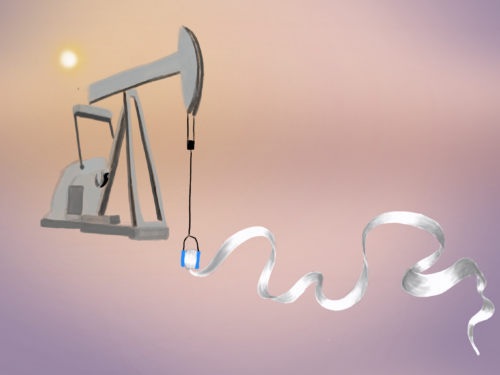Art Courtesy of Kara Tao.
Into the earth the oil well dips like a crane, dredging up
Slick-oils, sucking, gulping from the seafloor ancient crud
& festering remains of our ancestors: the turnover, the dredge,
Forgotten by all but time & rock & rot. Into the light they rain
Upwards, unwilling, compounds of bodies torn from dark sleep,
Filling test tubes, measured by blasts of radioactive sulfur. Cut up
& compartmentalized, monomers polymerized, fumigated under an
Indoor sky, inhaling the spiky scent of fluorine. The reactive turns inert,
Carbon dead-eyed behind a veil of single bonds. Molecules forget the pull
Toward entropy. They will never be bones again. They are stuck always in
Non-life, imitation bone—teflon—ugly name, ugly destiny, smooth vacuum
Of un-possibilities. Made here & there, again & again, more spilling out, frag-
menting, sifting into soil & water & bodies of fish & floating islands of plastic,
Until they gloss over the entire earth—slick, smooth, white. Almost like snow.
Artist’s Statement:
I read an article from a 1956 issue (Vol. 30 No. 8) of the Yale Scientific Magazine titled “Teflon Resin: Preparation and Characteristics,” further discussed in this issue on pg. 19. The article mostly describes how Teflon—a DuPont brand name for a resin made from polymerizing tetrafluoroethylene—was first produced. The Teflon polymer was originally discovered when a DuPont scientist noticed that it appeared in a powdery form when tetrafluoroethylene monomers were stored at super-atmospheric pressures. The article goes on to describe Teflon’s unique properties, the modern, efficient manufacturing process, and the “brilliant future” that the compound holds. I found it ironic and somewhat depressing to read this article—which was full of excitement for the chemical—from a modern perspective, knowing how damaging Teflon and other similar plastics have been to the environment.
I wanted to reimagine the discovery and production of Teflon from the perspective of the molecules used to make it. If they could think, how might these molecules, which once made up the bodies of living creatures before decomposing into oil, feel about being dredged up from the ocean? Humanity’s overconsumption and production of plastics disrupt Earth’s natural cycles of renewal, in which the biological decays, but remains natural. Once extracted from the earth, the compounds used to make Teflon experience all sorts of unnatural transformations, which I tried to evoke in my poem. For example, “radioactive sulfur” is a reference to the process used by the researchers to estimate Teflon’s molecular weight, and “fumigated under an indoor sky” represents the way the monomers are polymerized under intense pressure. The veil of fluorine is a response to one of the qualities of Teflon that the original article was so excited about: because the compound is essentially a string of carbons all single-bonded to fluorine, and C-F bonds are extremely strong, Teflon is remarkably inert, both chemically and physically. How might carbon molecules, which are used to interacting with the world through biological reactions, feel about being cut off from the world by these C-F bonds?
Finally, I wanted to move beyond the scope of the original article to discuss the overproduction of Teflon and other plastics. The overproduction of plastic contributes to global warming, and plastic itself inevitably leaks into and pollutes the environment. I made my lines progressively longer, so the poem itself spills outward. In an age where more and more of the environment has been affected by humans—with pollution and global warming changing even the atmosphere and weather patterns—are we dooming ourselves to a world where artificial wonders such as Teflon replace natural ones?

